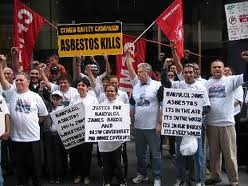
Asbestos was commonly used in building and insulation until
the early 1970s. It is now known to cause lung cancers such as mesothelioma.
The most insidious aspect of this condition is that it usually occurs 15 or 20
years after exposure to asbestos. Asbestos-linked diseases are common amongst
workers at asbestos mines.
The James Hardie Group operated an asbestos mine at
Baryulgil Square on the far north coast of New South Wales from 1944 to
1976. Aside from a few white
managers, Aboriginal Australians comprised the Baryulgil workforce.
There were reports that the Baryugil mine had often been
suffused in a cloud of asbestos dust from the mining and crushing
operations.
Workers said that
often they could not see from one side of the mining site to the other and
during the bagging of the crushed asbestos the thick clouds of dust made it
impossible for the person shovelling to see the person holding the bag. The
mine tailings were also piled near the Square and dust blew over the mine
workers’ houses. Roads in and
around the Square were commonly sealed with the asbestos tailings. There were stories of children rolling
in the dust as the tailings were being dumped from the trucks.
After media stories on asbestos-related illnesses at
Baryugil, the Standing Committee on Aboriginal Affairs in the Federal House of
Representatives conducted an inquiry.
The Aboriginal Legal Service requested that PIAC assist by preparing a
detailed submission. PIAC engaged
an Aboriginal law student, Murray Chapman, and Larry Strange, an expert in
occupational health issues. The submission formed a major
part of the evidence before the Parliamentary Committee and was relied upon in
its Report.
The Committee’s report, tabled in Parliament in October
1984, was a mixed bag for the workers of Baryugil Square. Disappointingly, the Committee refused
to recommend compensation for the mine workers, although it recognised that
there were legal difficulties in them bringing common law claims.
However, the Committee did strongly condemn the failure of
the company to protect its workers.
It found that while the dangers of asbestos were not known to the
general public and many doctors until the early 1960s, James Hardie, as a major
international asbestos company, was in a position to know of major overseas
studies and reports at a much earlier point.
The Committee also found that the company made greater
efforts to reduce the risk of exposure to asbestos in its factories and other
operations than at the mine, although mining operations were by their nature
potentially far more dangerous.
The Committee also heavily criticised the state health and mining
officials for failure to adequately guard the welfare of the mine workers. The inspectors apparently gave
forewarning of visits to the mine manager, who then cleared up the site.
Recommendations were made for changes in the compensation
laws to accommodate the special situation of Aboriginal workers. For example, most marriages of mine
workers were according to traditional Aboriginal law and therefore considered
to be de facto marriages in white law, which meant the spouses of deceased
workers were excluded from seeking compensation. Some of these changes have
since occurred as a result of general reforms in the law
affecting de facto relationships, both in the white and black communities.
Baryulgil workers were not able to secure compensation
through common law actions. The main problem proved to be the requirement that
actions be brought within six years of injury. There is provision in NSW for an
extension of one year where a previously unknown material fact comes to light.
However, this provision is confused and complex and fails to adequately deal
with the problems posed by latent injuries.
Return to Celebrating 30 years of public interest advocacy
Return to People power: commitment, energy and dedication
Photo: Baryugil Mine protesters. Photo courtesy of Matt Peacock, ABC.